Ultimate Guide to Open-Source CRM Integration

Open-source CRMs are a game-changer for businesses looking to customize their customer management systems while keeping costs low. These platforms allow full access to the source code, enabling tailored solutions that fit your business needs. Integrating these CRMs with marketing automation tools can increase conversion rates by 300%, improve productivity by 34%, and boost sales by 29%. Here’s what you need to know:
Key Takeaways:
- Top CRMs: SuiteCRM (customization-focused), Odoo (modular), Vtiger CRM (user-friendly), OroCRM (ideal for B2B/e-commerce).
- Integration Tools: Options like n8n (flexible workflows), native modules (easy setup), and custom APIs (advanced control).
- Lead Optimization: Multi-step forms, conditional logic, and real-time data validation improve lead quality and engagement.
- ROI Potential: Open-source CRMs can cut ownership costs by 50% and are projected to grow to $5.94 billion by 2030.
Quick Comparison of CRMs:
| Platform | Best For | Strengths | Rating |
|---|---|---|---|
| SuiteCRM | Customization, Low Cost | Free, community-driven | 4.2/5 (91+) |
| Odoo | All-in-One CRM/ERP | Modular, scalable | 4.1/5 (139+) |
| Vtiger CRM | Workflow Flexibility | Balanced features, ease of use | 4.3/5 (410+) |
| OroCRM | B2B/E-commerce | Advanced segmentation | 4.9/5 (9) |
Choosing the right CRM and integration method depends on your technical skills, budget, and business goals. Whether you’re a small team or a large enterprise, this guide will help you align your tools for maximum efficiency and growth.
SuiteCRM & Mautic Integration Tutorial | How to Sync Your CRM & Marketing Automation
Top Open-Source CRM Platforms for Integration
When it comes to open-source CRM tools, finding one that offers the right mix of customization and integration is key to effective marketing automation. Below, we explore some of the top options, each with unique features designed to enhance lead management and streamline workflows.
SuiteCRM
SuiteCRM is a standout choice for businesses seeking a cost-effective, community-driven platform. It provides centralized data management and highly adaptable workflows, allowing for seamless custom integrations. With no licensing fees and a 4.2-star rating from over 91 reviews, it’s a solid investment. On average, every dollar spent on SuiteCRM reportedly yields $8.71 in returns.
Odoo
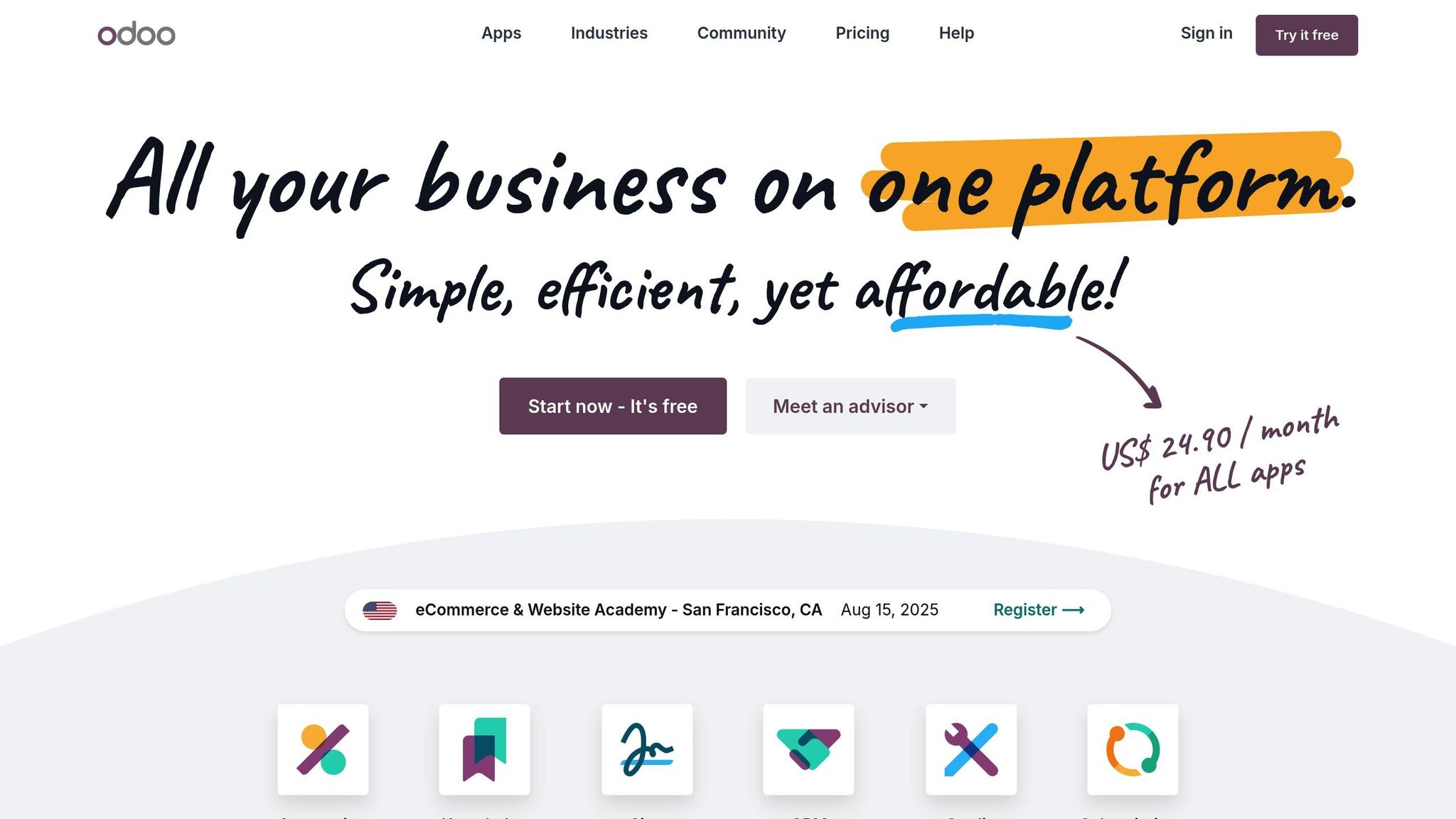
Odoo combines CRM and ERP functionalities into a single, modular platform. This flexibility lets businesses start with basic CRM features and expand by adding modules as needed. Its extensive marketplace of add-ons further boosts integration possibilities. Odoo offers a free plan, with premium options starting at $7.25 per user per month. With a 4.1-star rating from 139+ reviews, it’s ideal for businesses looking for an all-in-one solution. However, its strict storage limits and the need for technical expertise may require additional resources to fully utilize its capabilities.
Vtiger CRM
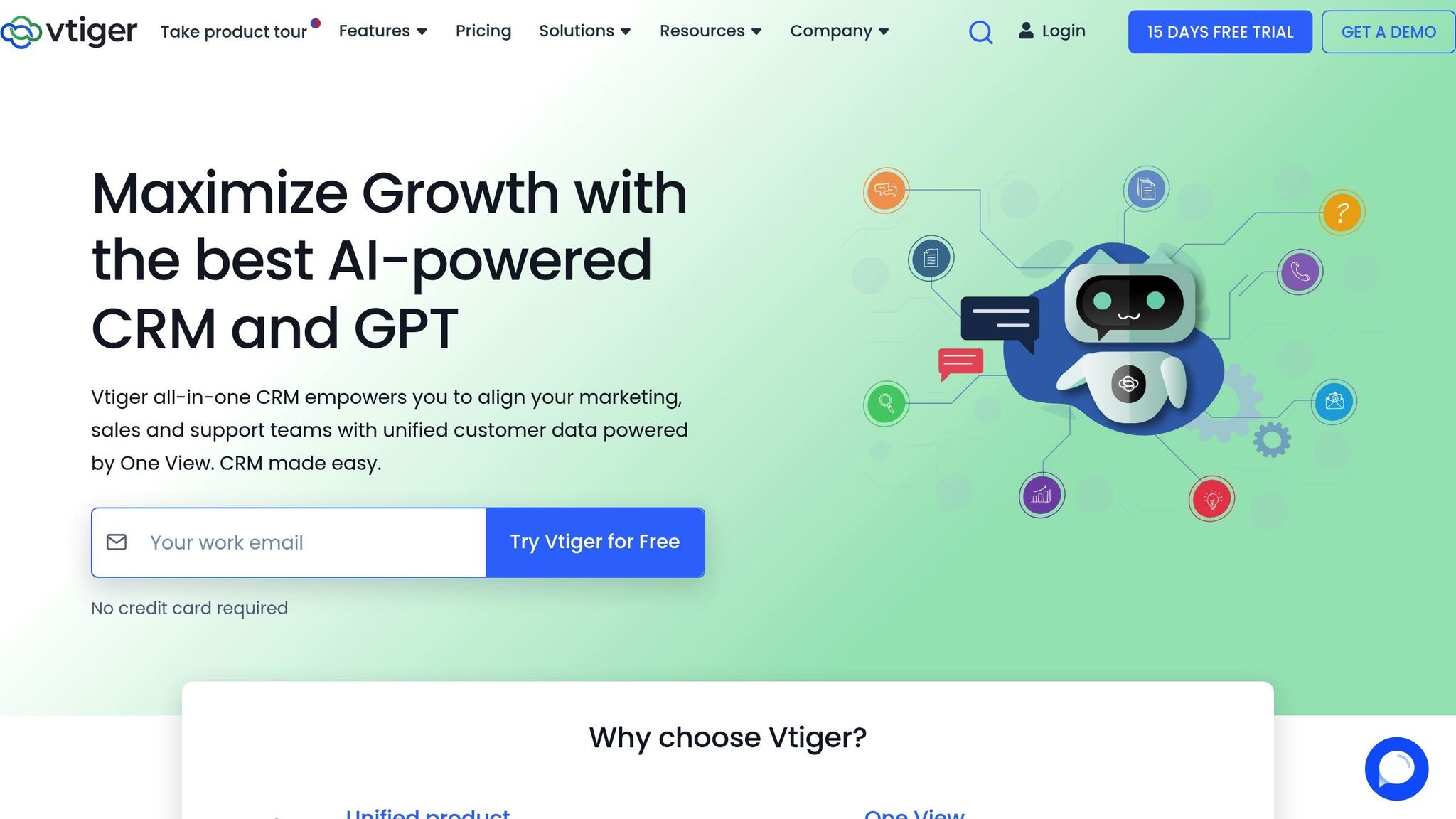
Vtiger CRM is known for balancing functionality with ease of use, making it a great choice for businesses with specific workflow requirements. Originally a fork of SugarCRM, it has grown into a robust platform with strong community support. With over 5.4 million downloads on SourceForge as of April 2025, it’s the most downloaded open-source CRM in its category. Vtiger offers a free One Pilot plan for up to 10 users, while paid plans range from $12 to $42 per user per month (billed annually). Its 4.3-star rating from over 410 reviews highlights its reliability, especially for organizations integrating marketing automation. Built-in automation and third-party extension support further enhance its efficiency.
OroCRM
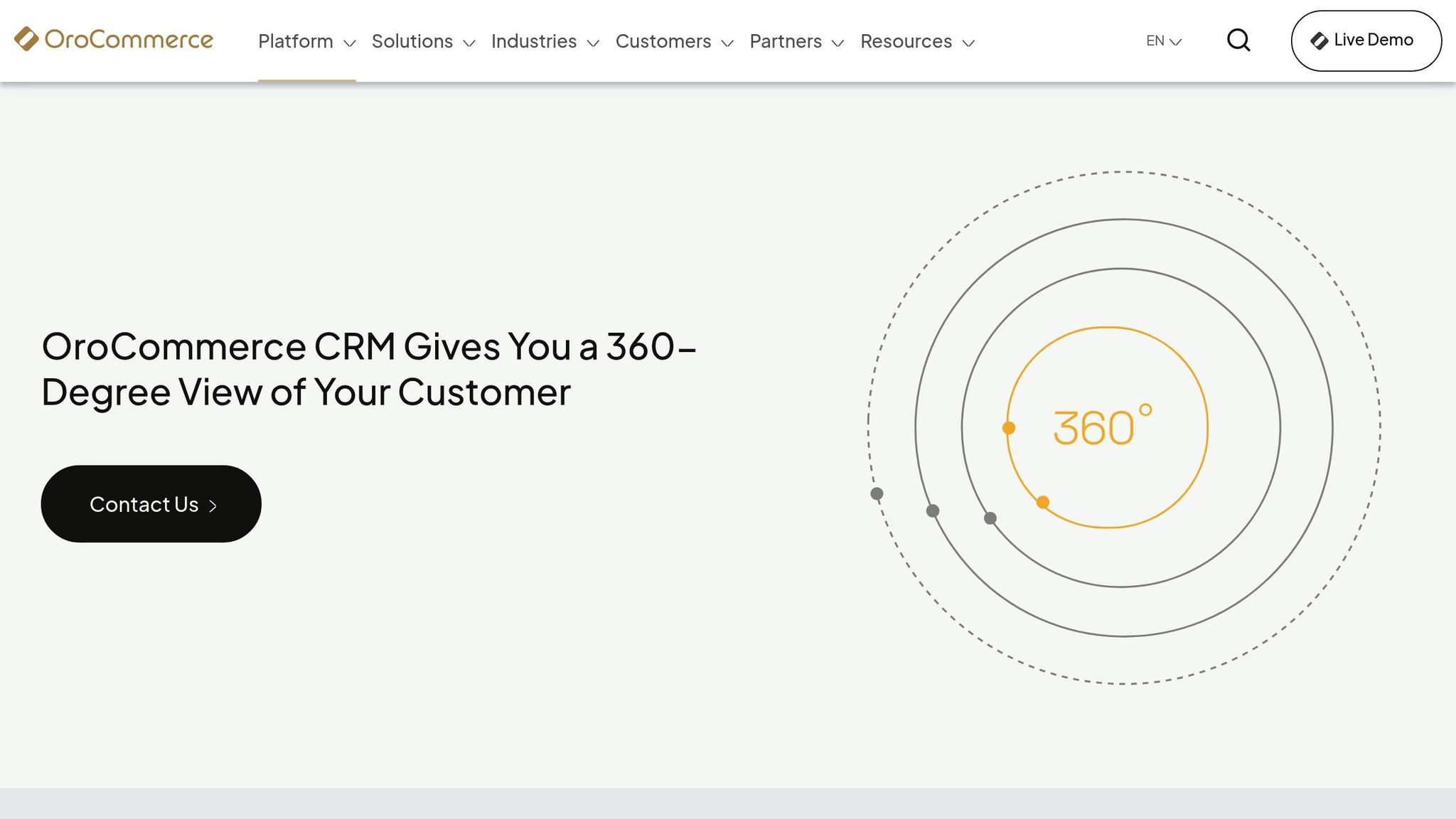
OroCRM caters specifically to B2B and e-commerce businesses, excelling in areas like advanced segmentation and automation. Designed for complex sales cycles and account-based marketing strategies, it provides detailed insights into customer behavior, which are crucial for effective lead nurturing. With a 4.9-star rating from 9 reviews, OroCRM has earned high satisfaction among users in its niche.
Here’s a quick comparison of these platforms:
| Platform | Best For | Key Strengths | Rating |
|---|---|---|---|
| SuiteCRM | Community Support, Low Cost | Extensive customization, free | 4.2/5 (91+ reviews) |
| Odoo | All-in-One CRM/ERP | Modular design, scalability | 4.1/5 (139+ reviews) |
| Vtiger CRM | Workflow Customization | Balanced features, strong community | 4.3/5 (410+ reviews) |
| OroCRM | B2B, E-commerce | Advanced segmentation, automation | 4.9/5 (9 reviews) |
Integration Tools for Open-Source CRMs
The right integration tools can transform your open-source CRM into a streamlined system that bridges marketing and sales. These tools connect platforms, automate data transfers, and create workflows that save time while cutting down on errors. Below, we’ll dive into three integration approaches that can enhance your CRM’s capabilities.
n8n
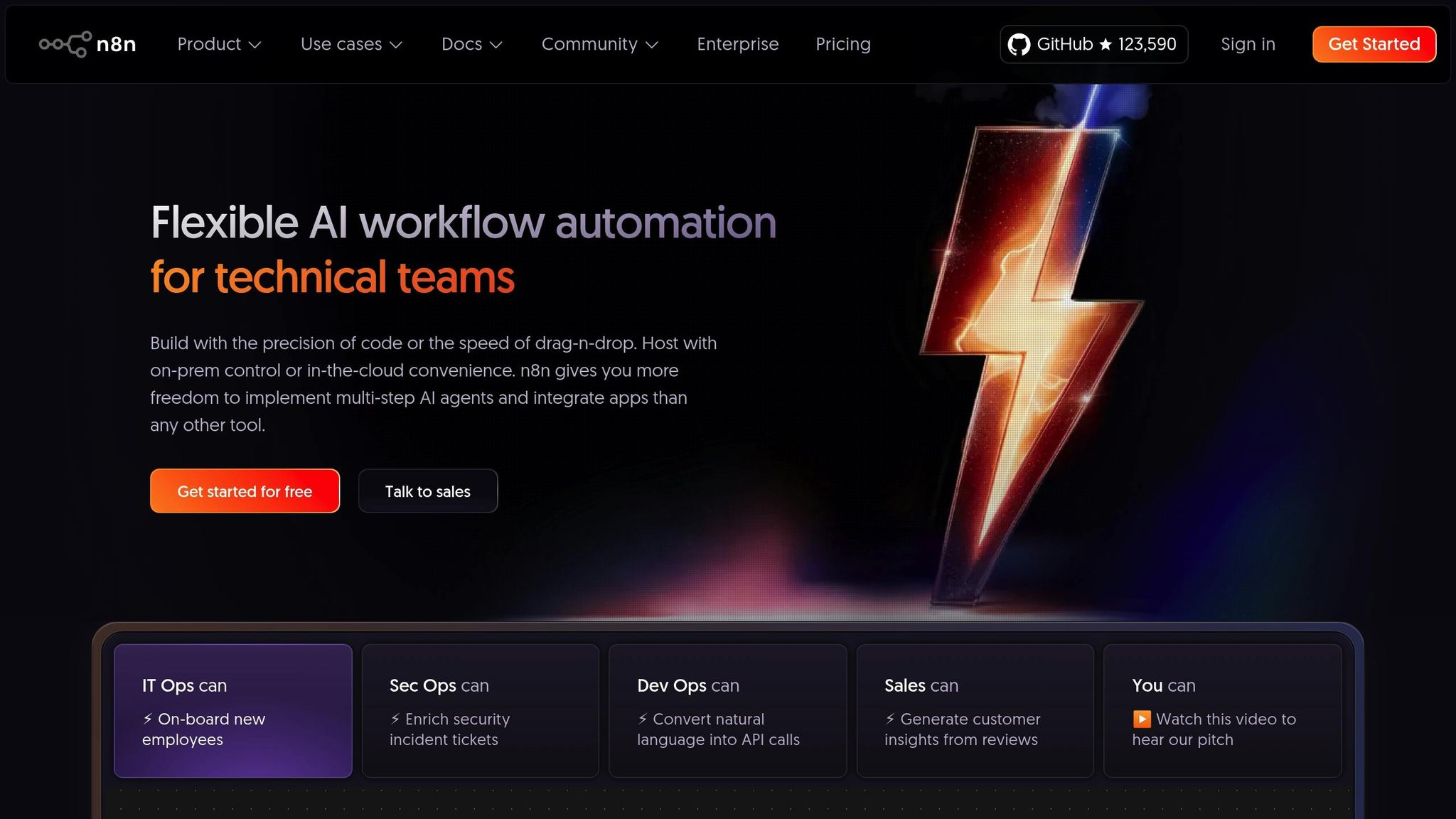
n8n is a powerful automation tool that links open-source CRMs with over 400 apps, including popular platforms like Salesforce, HubSpot, and Zoho CRM. Its standout feature is the ability to manage workflows with branching logic and conditional operations, making it highly versatile.
The platform offers a user-friendly, visual interface, making it accessible to those without coding expertise. For advanced users, there’s the flexibility to embed JavaScript or Python code. Unlike many automation tools, n8n charges only for full workflow executions, with cloud plans starting at $25/month for 5,000 executions, making it a cost-efficient option.
n8n also excels at data enrichment. It can clean and validate data, verify email addresses, and enhance lead profiles with external information before the data enters your CRM. Additionally, it supports real-time automation triggered by events like new leads or customer interactions. For instance, one consulting firm used n8n to automate tasks when a lead moved to "Closed-Won" in Salesforce. The workflow automatically sent contract requests, created Google Drive folders, and generated Asana tasks, reducing the onboarding process from days to hours and ensuring timely billing.
Native Integration Modules
Many CRMs come equipped with built-in integration modules, offering a quick and straightforward way to connect with popular marketing tools and services. These native modules are often the fastest way to set up integrations, requiring minimal effort to get started.
SuiteCRM, for example, provides a range of native integration options through its marketplace. These include connectors for email marketing platforms, accounting software, and e-commerce systems. Its modular design allows businesses to add integrations as needed without disrupting existing workflows.
Odoo goes a step further by combining CRM and ERP functionalities in one platform. Its marketplace offers hundreds of add-ons that connect with tools for inventory management, project tracking, and more. This all-in-one approach is particularly appealing for businesses looking for a comprehensive solution.
While native integrations are easy to set up and maintained by the software provider (ensuring updates and security patches are handled), they may lack the customization options that more tailored solutions can provide.
Custom API Solutions
For businesses with unique workflows or more complex needs, custom API integrations offer unmatched flexibility. These solutions are specifically designed to align with your business processes, handling intricate data relationships that standard tools can’t manage.
Custom API projects often involve a higher upfront investment - typically starting at $15,000 or more for complex integrations. However, they provide complete control over functionality, data sharing, and system connections. This makes them especially valuable for organizations with specific security requirements or large-scale operations.
Developing custom APIs involves aligning data structures, designing secure endpoints, and implementing error-handling mechanisms. While this requires skilled developers and ongoing maintenance, the result is a solution tailored to grow with your business.
The benefits are clear: companies using APIs are 24% more likely to achieve success, with integrations boosting customer satisfaction by 20% and cutting operational costs by 15%. For businesses with complex requirements, this approach can be a game-changer.
Choosing the Right Approach
When deciding between these integration methods, consider your technical expertise, budget, and timeline. Native integrations are ideal for standard tasks and fast implementation, while custom APIs are better suited for handling specialized, complex needs. Many businesses find success by combining both - using native integrations for everyday processes and custom APIs for unique challenges.
To get the most out of your integration tools, start with pilot workflows, test them thoroughly in a sandbox environment, and monitor their performance daily. This ensures your tools deliver the automation and efficiency gains that make open-source CRMs so effective.
sbb-itb-5f36581
Best Practices for Form-Based Lead Generation and CRM Integration
Effective lead forms are the backbone of connecting your marketing efforts with your CRM, enabling immediate engagement and providing actionable sales data. With 17% of sales-qualified leads coming from website contact forms, it’s clear that well-designed forms and smooth CRM integration are critical for driving results. Paying attention to form design, functionality, and integration can make a substantial difference in your lead generation success.
Multi-Step Forms and Conditional Logic
Multi-step forms are a game-changer for simplifying lead capture. Instead of overwhelming users with a long list of questions, these forms guide them through smaller, manageable steps. This approach reduces friction, leading to higher completion rates - multi-step forms can generate up to 5x more leads compared to traditional single-page forms. And because these forms integrate seamlessly with CRMs, they ensure that data flows smoothly into your system.
Christopher Lier, a digital marketing expert, emphasizes the importance of this approach:
"Website forms are one of the most overlooked elements of digital marketing strategies. Changing traditional form designs to user-friendly multi-step forms is one of the best steps for B2B businesses to rapidly increase incoming lead generation volumes."
Conditional logic takes personalization to the next level. By adjusting the form fields based on a user’s previous answers, it creates a tailored experience. Progress indicators can further encourage users to complete the form. This personalized approach matters - 72% of customers say they only engage with tailored messaging. Conditional logic also helps filter out unqualified leads by asking targeted questions to the right audience, which ensures only relevant prospects enter your CRM.
Lead Enrichment and Validation
Incomplete or inaccurate submissions can clutter your CRM with low-quality data, making lead validation and enrichment essential. Lead validation ensures that details like email addresses and phone numbers are accurate and willingly provided. Considering that only 44% of marketing-qualified leads (MQLs) are deemed promising, maintaining clean and reliable data is crucial.
Lead enrichment goes a step further by transforming basic contact details into detailed customer profiles. For example, Oracle aggregates data from multiple sources to improve segmentation and targeting, while Amazon Web Services uses predictive scoring to prioritize leads based on factors like company size, industry, and engagement history. Speed also matters - responding to potential customers immediately can boost conversion rates by 25%. Real-time validation and enrichment ensure your team can act quickly, improving the chances of converting leads into customers.
Reform's Role in Optimizing Lead Capture
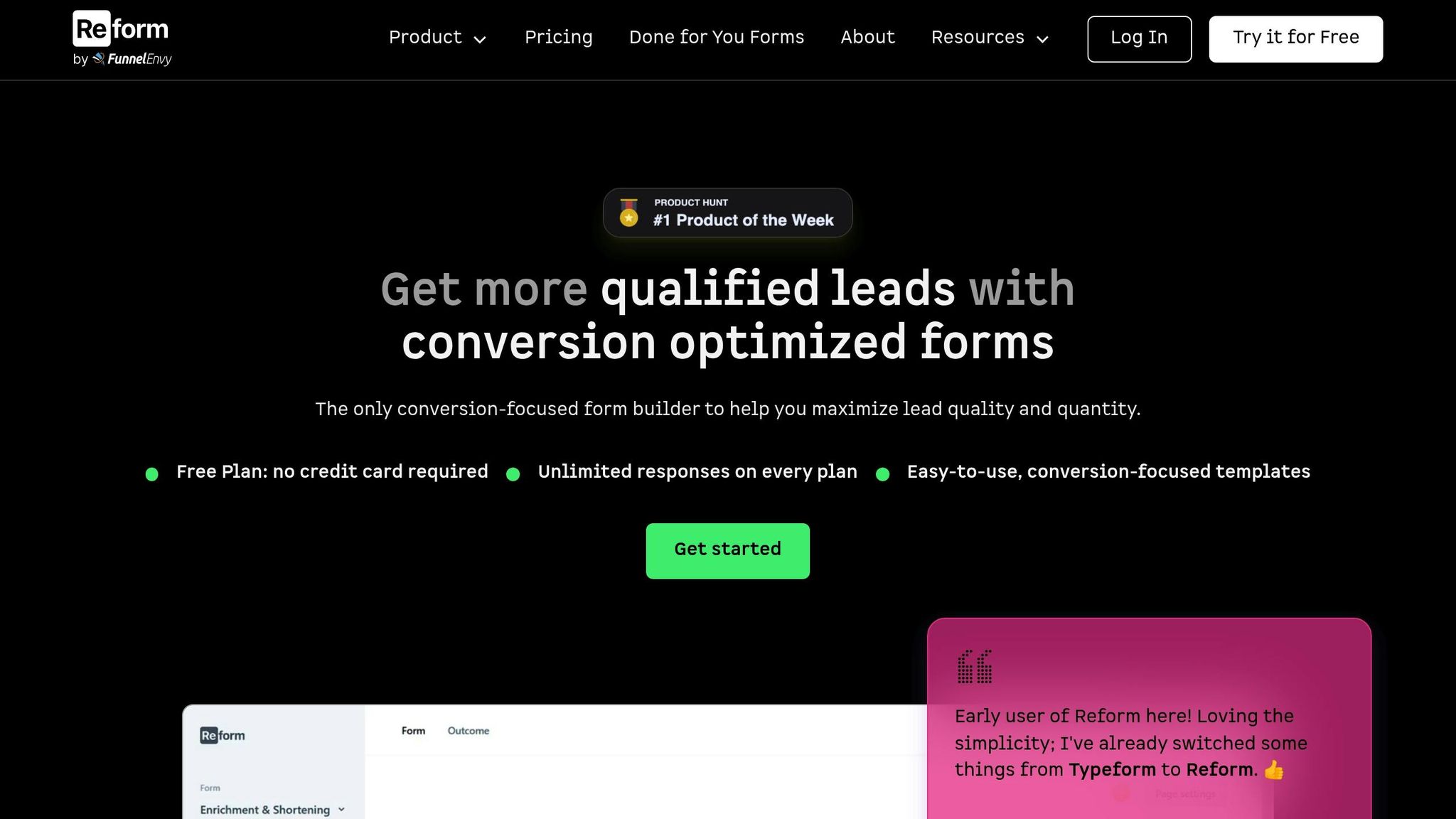
Reform simplifies lead capture with its no-code form builder, allowing businesses to create branded, high-performing forms without needing technical expertise. Despite its simplicity, Reform offers advanced features for seamless CRM integration.
The platform’s multi-step form capabilities and conditional routing provide a personalized experience for users. By tailoring questions to each visitor, Reform reduces friction and increases form completion rates. Additionally, the platform includes lead validation and enrichment tools, such as built-in email validation, spam prevention, and data enrichment, ensuring that only high-quality leads make it into your CRM.
Reform also offers real-time analytics, giving businesses instant insights into form performance, conversion rates, and user behavior. These insights enable continuous improvement through A/B testing of form elements and layouts. Beyond basic data transfer, Reform maps form fields directly to CRM properties and can trigger automated workflows, eliminating manual data entry and ensuring timely follow-ups.
A great example of Reform’s impact is ExactBuyer’s collaboration with FunnelEnvy. By using a custom Reform lead capture form, they not only boosted conversions from high-quality prospects but also filtered out spam and low-value leads.
Reform’s additional features, like abandoned submission tracking and progressive profiling, further enhance its lead capture capabilities. Abandoned submission tracking allows businesses to follow up with prospects who started but didn’t complete the form, while progressive profiling gathers more information over time, building stronger relationships without overwhelming new leads.
For companies leveraging marketing automation, Reform’s integrations are particularly valuable. Leads are automatically routed into the right nurture sequences based on their form responses, ensuring personalized follow-ups aligned with each prospect’s interests. Businesses that implement marketing automation often see a 451% increase in qualified leads, highlighting the importance of a well-integrated lead capture solution.
Evaluating Open-Source Integration Tools and Approaches
Selecting the right integration method for your open-source CRM is no small task. With the open-source CRM market projected to hit $9.4 billion by 2025, growing at a 20.4% CAGR, businesses have a wealth of options. And since 83% of SMBs rely on open-source software primarily for cost savings, finding tools that strike a balance between affordability and functionality is key.
The challenge is compounded by the fact that 70-90% of modern applications are built with open-source components. This means your integration choice will likely affect several systems across your organization.
Let’s break down the main integration methods - n8n, native integration modules, and custom API solutions - by looking at their cost, flexibility, and technical demands.
Comparison Table of Integration Tools
Here’s a quick overview of how these tools stack up:
| Feature | n8n | Native Integration Modules | Custom API Solutions |
|---|---|---|---|
| Supported CRMs | Wide range via APIs, custom nodes | Limited to CRM's module availability | Any CRM with a public API |
| Integration Complexity | High | Low to Medium | High |
| Flexibility | Very High | Limited | Very High |
| Cost | Low (self-hosted) to Medium (cloud) | Low to Medium | High |
| Community Support | Active developer community | CRM-dependent | Limited, depends on developer resources |
| Highlights | JavaScript functions, custom nodes, self-hosting | Pre-built integrations, ease of use | Full control, direct access to CRM data |
This table highlights the trade-offs, helping you pinpoint the best fit for your needs.
n8n is a standout choice for developers seeking maximum control and customization. With a 4.8/5 G2 rating, it’s highly regarded for its self-hosting option, which allows unlimited executions at no extra cost. Pricing starts with a free open-source version, while cloud plans range from $20/month for basic features to $50+/month for professional use.
Native integration modules are the easiest to implement, offering pre-built solutions right from the CRM vendor. However, their functionality is limited to what the vendor provides, which might not cover all your needs.
Custom API solutions give you the most control but come with a hefty price tag. They’re perfect for addressing highly specific requirements when other methods fall short, but they demand significant development and maintenance resources.
When to Use Each Method
Your choice of integration tool depends on your technical capabilities, budget, and business goals. Since 60% of businesses prioritize customization when choosing a CRM, it’s crucial to align your approach with your unique needs.
- n8n is ideal for teams with strong technical expertise. It’s perfect for organizations with in-house developers who can handle the platform’s learning curve. If you need complex workflows, JavaScript logic, or want to avoid vendor lock-in, n8n is a great option.
- Native integration modules shine when you need quick and simple deployment. They’re best for standard use cases where the CRM’s built-in tools meet your needs. This is especially useful for smaller teams without dedicated developers or for businesses that want fast results.
- Custom API solutions are the go-to choice for large enterprises with complex workflows. They’re suited for scenarios where direct database access or specialized data transformations are required. However, make sure your team has the technical resources to manage ongoing maintenance.
Key Considerations for Integration
Technical readiness is a critical factor. If you have in-house or outsourced developers, you can explore the flexibility of n8n or custom solutions. Without technical expertise, native modules are often the safest bet.
Security is another major consideration. Open-source tools demand diligent vulnerability management, as many organizations lack visibility into the open-source components they use. Regular security audits and an up-to-date inventory of dependencies can help mitigate risks.
Your deployment model also matters. While 67% of companies prefer cloud-based CRM solutions for their scalability and flexibility, 22% still opt for on-premises deployments due to privacy and security concerns. Your integration tool needs to align with your chosen deployment approach.
Finally, budget constraints often dictate the final decision. For example, n8n offers cost-effective scaling through self-hosting, while custom API solutions require a significant upfront investment. Native modules usually strike the best balance between cost and functionality, making them a popular choice for standard use cases.
Conclusion: Maximizing ROI with Open-Source CRM Integration
This guide has outlined how open-source CRM integration can create a unified system that delivers measurable ROI. Achieving success hinges on making thoughtful decisions in three key areas: selecting the right platform, choosing the best integration method, and optimizing lead capture strategies.
Selecting the right CRM platform is the cornerstone of your integration strategy. Whether you lean toward SuiteCRM for its extensive customization options, Odoo for its all-in-one business capabilities, or Vtiger for its balanced features, your choice should align with your business goals and technical requirements.
Open-source CRM solutions can reduce total ownership costs by up to 50% compared to traditional systems. This includes hosting, maintenance, customization, and training expenses. Your integration approach - whether using tools like n8n for flexibility, native modules for simplicity, or custom APIs for enterprise-grade needs - will influence these ongoing costs. These efficiencies directly impact your ability to optimize lead generation efforts.
The real ROI comes from lead capture and conversion optimization. Reform’s conversion-focused tools, highlighted in this guide, integrate seamlessly with open-source CRMs to enhance lead quality from the first interaction. Features like multi-step forms, conditional routing, and lead enrichment ensure a smooth pipeline. Real-time analytics and abandoned submission tracking help capture every opportunity. Companies that respond to leads within an hour are seven times more likely to qualify them. Reform’s CRM integrations automate lead syncing and trigger immediate follow-ups, enabling rapid responses that boost conversion rates.
Data synchronization and workflow automation are pivotal. Studies show that 88% of marketers report increased leads, and 77% see higher conversion rates through these strategies. The key is selecting an integration method that ensures real-time data flow without bottlenecks or inconsistencies.
As your system matures, additional factors like security and compliance become critical. With 71% of businesses struggling to achieve a unified customer view, rushed integrations can introduce vulnerabilities. Regular audits, strict access controls, and adherence to data protection regulations are essential for long-term success.
Looking ahead, the AI-powered CRM market is expected to grow from $1.1 billion in 2020 to $6.1 billion by 2025. Choosing integration tools that adapt to emerging technologies will help future-proof your system.
Ultimately, maximizing ROI from open-source CRM integration requires clear goals and ongoing optimization. Businesses that treat integration as a continuous, strategic initiative - not just a technical project - are the ones that truly reap the rewards.
FAQs
What are the key advantages of integrating open-source CRMs with marketing automation tools?
Integrating open-source CRMs with marketing automation tools can make a big difference in how your business operates. By bringing these systems together, you can simplify workflows, save time, and improve customer experiences by keeping data in one place and automating routine tasks.
This combination allows businesses to customize communication, creating more targeted and engaging interactions with customers. It also delivers key insights into customer behavior, helping you refine your marketing strategies and boost sales performance. Plus, quicker response times and more effective lead management can lead to higher conversion rates and stronger connections with your customers.
What factors should businesses consider when choosing the right open-source CRM platform?
To choose the best open-source CRM platform, businesses should start by identifying their unique needs and priorities. Here are some key aspects to consider:
- Ease of use: The platform should be straightforward and simple for your team to navigate and use effectively.
- Customization: Opt for a CRM that lets you adapt its features to fit your specific workflows and processes.
- Integration capabilities: Make sure the software can connect effortlessly with your existing tools, like marketing automation platforms or form builders.
- Scalability: Select a platform that can grow alongside your business as your requirements expand.
- Community support: An active user community can be a goldmine for resources, advice, and troubleshooting help.
- Security: Protecting sensitive customer data is crucial, so verify the platform's security measures.
- Cost considerations: While many open-source CRMs are free, factor in potential expenses for hosting, support, or premium features.
By evaluating these elements, businesses can find a CRM solution that not only meets their current needs but also positions them for long-term success.
How do I decide between using n8n, built-in integration tools, or custom APIs for CRM integration?
When choosing the right CRM integration, your decision should align with your technical requirements, available resources, and long-term objectives. Here's a breakdown of the options:
- n8n: Perfect for developers who need advanced workflows and a high level of customization. While it offers plenty of flexibility, it does demand technical expertise to set up and manage.
- Built-in integration tools: These native modules are easy to use and quick to implement, making them an excellent choice for teams without technical skills. However, they might fall short when dealing with more complex workflows.
- Custom APIs: If you’re looking for maximum control and the ability to create highly tailored integrations, custom APIs are the way to go. That said, they require a significant investment in development and ongoing maintenance.
To choose the best option, think about your team’s technical capabilities, the complexity of your workflows, and how much room for growth and scalability you’ll need down the road.
Related Blog Posts
Get new content delivered straight to your inbox

The Response
Updates on the Reform platform, insights on optimizing conversion rates, and tips to craft forms that convert.
Drive real results with form optimizations
Tested across hundreds of experiments, our strategies deliver a 215% lift in qualified leads for B2B and SaaS companies.


.webp)



